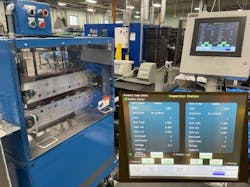Eagle Elastomer Inc., a custom mixing and extrusion company, is a job shop. One extruder could see two or three setups in a single shift, making logistics and task management of paramount importance. And in 2016, five years after completing a major IIoT project, President Reagan McHale realized that while the company did well financially, he wasn’t so sure about how efficient it was. So why not use the mountains of data he was collecting to try and figure it out?
Manually written production schedules and handwritten operator records were the norm at that time, creating voluminous folders’ worth of paper to comb through for research. If internal problems or customer issues arose, finding the data was a time consuming challenge.
Around 2004, Eagle Elastomer implemented a PC-based data acquisition system to capture basic extrusion data and enter it into two SQL databases. IoT devices record data on pressure, temperature and amperage pulled by machines, along with other measurements.
“We were able to work with the company that manufactures those devices,” says Brian Chandler, manager, process development at Eagle Elastomer. “Fortunately, with the extruder industry, the company that we work with was tied in with a lot of those people. So, a lot of times I didn’t even have to be in the middle. They would just communicate to each other with what we have and what we need to do, then let me know, for resources and cost, what I would need to do on my side.”
Extruder operators and finished product inspectors worked closely with the company that provided the data acquisition system to specify what information was to be gathered and how often it should be recorded. “For the majority of the time when we’re making a major purchase, we’ll consult with employees, plan out what we want to do and they’re involved in the process,” Chandler says.
Four data systems in total were installed, with the final system completed in 2011. “That seems like a long period of time, between 2004 to 2011, from our first system to our last system. We have four extruder lines, we did a pilot on one line and got that to where we thought it was mastered,” Chandler says. “If we would’ve went all four from the very beginning, I think that would have been challenging, bringing that data in and separating it, because they’re all the same parameters.”
The installation in 2011 of the fourth data acquisition system ended the first phase of the company’s data analytics initiative. The data tables produced by these systems provided insight on changes in process parameters and their effects on final products.
Sometimes You Listen to “What if?”
“In 2009, 2010, we were trying to get our operators to schedule their own lines,” McHale says, “and that was a little bit trying for us. They didn’t want to do it; they didn’t understand why we were asking.” Management pulled back, and production or plant managers were put in charge of line scheduling.
“We had a report that we printed out of our ERP system with all the orders. We were able to take that report and modify it a little bit so that it would give the orders by compound,” McHale says. Schedules were written out by hand, based on those reports.
“Sometimes we may have over-planned and didn’t get a few of our jobs completed. Sometimes we may have under-planned and had a little bit of extra time at the end of the day. And one of the key components in that was understanding the time each job took,” says technical manager Zack Sutliff. “From the mixing side, we would have a general idea of how long a job would take. And, if you have 16 of the same item you need to produce, we kind of knew how long it would take. But we didn’t have it very defined anywhere.”
Eagle Elastomer did well financially during this time, McHale says, such that addressing these inefficiencies wasn’t a priority. Finally, in 2016, the company began asking questions about operating schedules and efficiency, in part by realizing it had untapped capabilities.
“We’ve had times in our business where we’ve picked up a new piece of business and it’s been considerable volume. We used to ship 2,000- or 3,000-foot orders. Now we're doing 50,000 foot orders, and some custom parts and things of that nature. The volumes are much, much higher today than they ever were. And I think that was probably one of the pain points that we had back in the 2015-2016 range,” McHale says.
When large volume orders for new types of applications came in, planning for this on extrusion lines proved challenging. The company had a standard two-to-three week lead time that, when combined with large volume orders, led to going late and creating tension between production, engineering and management.
“Someone in our group said, ‘We’ve got all this data. Can’t we do something with that data to understand how we’re performing and how to plan better?’ And then we started to tinker and came up with a few things,” McHale says.
Making the Most of Digital Tools at Hand
“We captured the time that these [mixing] jobs took, I mean exact times, and from there we worked with our ERP system support group who helped us to create fields in our ERP system where we could put time factors in for these jobs,” Sutliff says,”[like] for mixing on a per pound basis. This factor, times the [number of] pounds, produces the time spent for that production day on that job.”
Reports that tracked the total number of tasks performed in a production day, and the time each task required, were soon emailed at the end of each day to employees. Having the information enabled managers to set productivity goals, gradually pushing the envelope on how many hours a given line at the plant ran per day.
“We just kept taking those steps to improve our efficiency. Those reports were… key in the communication to our operators to all levels within the organization,” Sutliff says.
“On the extrusion side, with the scheduling of the operators, now that they were getting a schedule that was more realistic to their day, they would give feedback to the scheduling manager,” Chandler says. “I know from my side when I’ve helped out in scheduling, that’s been very instrumental.
“I think prior to us doing this there was a big communication gap. It was kind of more robotic, whereas now it’s information sharing and pre-planning and looking. If I run this quantity or these times or this order, how does it affect that process? But, not only that process, the subsequent process as well,” Chandler says.
“It probably took us a few years to get to this point. But, I would say for the last two to three years, we rarely miss our [efficiency] mark,” Sutliff says. “And that’s due to this report and the mixing time factors that we put in and the production goals that we’ve set.”
Realizing the power of meshing their SQL and ERP data, the company then began formally merging the two systems. “Between 2011 and 2016, although we didn’t have the merger, we were still using both sides, both data [sets]. It just wasn’t efficient,” Chandler says. “It wasn’t together in a convenient, single report. It was multiple reports. And it took time to gather all that information, to meet and to make the best [scheduling] decision.”
Tying the data acquisition and ERP systems together allowed the distribution of streamlined reports across departments such that teams can easily see how their schedules affect others’, addressing a long-standing pain point.
“In our extrusion department we have extrusion, we have vulcanization, we have final inspection. And so [in the past], we were making plans, and sometimes we would run a huge amount of product and then, the next day, curing or vulcanization is just completely inundated,” McHale says. Now, with access to the reports, departments can review schedules across the plant and make suggestions about how better to coordinate amongst one another.
The Inarguable Benefits of Digitization
Thanks to the efficiency and planning flexibility afforded by their data analytics, Eagle Elastomer can handle new and significant challenges more smoothly than ever.
Production volume is currently up 30%. A customer in Australia faced a shutdown situation and needed a fast production job. Eagle Elastomer fit the job into its schedules smoothly. Now, the customer forecasts ordering thousands of feet per month of product. Another customer in Europe quadrupled its volume with Eagle Elastomer in 2021.
“If Brian and Zack had not put these systems in place and developed the teams around them, we would be really struggling. In the past, we’d had these instances where we picked up this new business and we did struggle,” McHale says. “Now, we’re very quick to adjust lead times, we’re very quick to inform customers are very quick to plan out the production to get the right order quantities, to get the maximum benefit through the production floor. And we’re doing that together with our production teams. It’s a team approach.”
McHale adds, “Our profit level [in 2021] has been strong. Our sales revenue has been strong, our scrap is going down, our rework is going down, our on time delivery is going up. And we didn't change anything other than we’re starting to make better decisions together, off the information that's being presented to us on a daily basis.”
About the Author
Dennis Scimeca
Dennis Scimeca is a veteran technology journalist with particular experience in vision system technology, machine learning/artificial intelligence, and augmented/mixed/virtual reality (XR), with bylines in consumer, developer, and B2B outlets.
At IndustryWeek, he covers the competitive advantages gained by manufacturers that deploy proven technologies. If you would like to share your story with IndustryWeek, please contact Dennis at [email protected].



